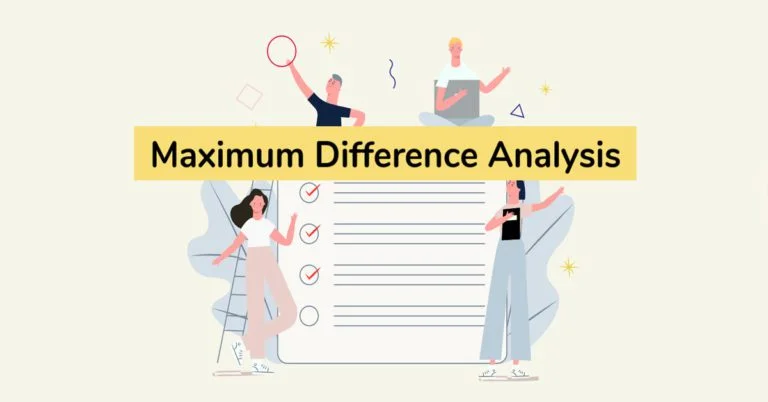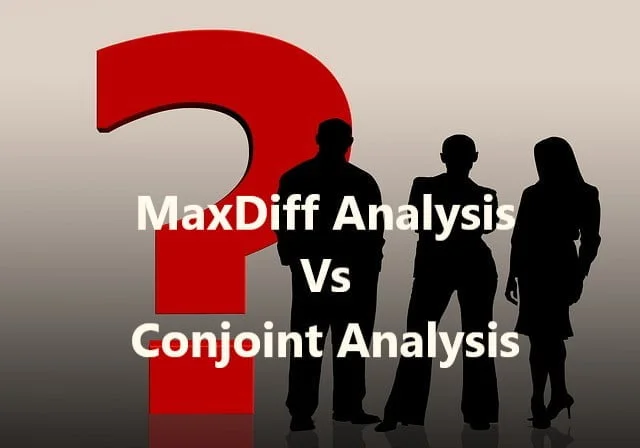Market research provides market size, trend, competition and demands of customers before any company takes any of their product or service in the market. The importance of customer’s choices is for the evidence-based decision. Quantitative research becomes an important part of any business to take products or services according to the customer level. MaxDiff Analysis, Maximum Difference Analysis is a very efficient way to solve out this quantitative research statistically and analytically. In our last article, we learned about Business Approach to Conjoint Analysis and now we are moving to MaxDiff Analysis and MaxDiff Scaling.

What is the Maximum Difference Analysis?
Maximum Difference Analysis, firstly introduced by Sawtooth Software, is like ‘most-least’ method. This method run over multidimensional perceptions unlike other methods following unidimensional percepts. This analytical method does not require the estimation of the cognitive parameter that occurs in the analysis of rating data. Understanding MaxDiff Analysis directly leads to the understanding of MaxDiff Scaling first. Let’s learn, what MaxDiff Scaling is?
MAXIMUM DIFFERENCE SCALING
The rating system out of five stars is not what MaxDiff meant to be. It is replacing standard and problematic rating questions with grid-style ratings. Maximum Difference Scaling is also called as best-worst scaling. The reason for calling it best-worst scaling is because it might choose best from n items and worst from n-1 items. It is not the Conjoint Method but it is very similar. The use of MxDiff is to measure the preference and importance within the list of objects such as product features, advertising claims, product packaging, brands and job-related factor.
Use of MaxDiff Analysis in Business
This is the grid-style rating system in which respondents can answer quickly about products and services. Maximum Difference Analysis is a time saver process as it doesn’t require to answers dozens of questionnaires. It is very easy to provide data on the numbers of product features or brands.
Analysis of Maximum Difference Data
The Analysis of Maximum Difference Data is done in 4 methods:
-Counting Analysis(Best-worst Percentage)
-Best-Worst Difference
-Estimated Scores applying Statistical Model
-Disaggregate Analysis
Maximum Difference Analysis versus Conjoint Analysis

Every method comes with its unique features and significances. Maybe there is a lot of similarities in Maximum Difference Analysis and Conjoint Analysis, but both have differences too. MaxDiff analysis does not require the structured organization of attributes. It is done on a common scale and list number of items there. All items might get directly compared there. MaxDiff prohibitions are much lesser detrimental to obtaining stable score estimates than Conjoint Analysis. It is more accurate than the Conjoint Analysis.
Concerns while using MaxDiff
MaxDiff data is usually longer than Traditional data and takes three times longer to complete a survey. There is a lot of asymmetrical information in this method as best-worst scaling makes huge difference. Its main focus is on achieving stable estimates on both, best and worst items. It has an arbitrary scale origin i.e. the comparative nature of selecting a best and worst items. But also its a concern that the scores have an arbitrary origin.
PREDICTIVE VALIDITY OF MAXDIFF SCALING
Standard MaxDiff is free from the scale using bias. Importantly, it is more discriminating than the standard rating based method. But understanding buyers’ honest preference and motivation for any product or service are paramount. It is very accurate in predicting holdout choices and brand preference than the Traditional method.
Closure
As it came forward that the accuracy of predictable analysis of choices and brand preference than other methods, MaxDiff is making its place in the market to run out many businesses. With increasing customers, their demands and preferences will increase accordingly, we need to analyze sharply with their sorted choice and demands for products and services.
Authors
Sundeep Chowdary is a Manager at Factspan. He has 7+ years of analytics experience holding strong analytical and statistical knowledge.
Nipa Sarkar is an Associate Business Analyst at Factspan. She is very dedicated to her work. Besides work, Nipa likes listening to music and painting.
>>Must read Business Approach to Conjoint Analysis.










